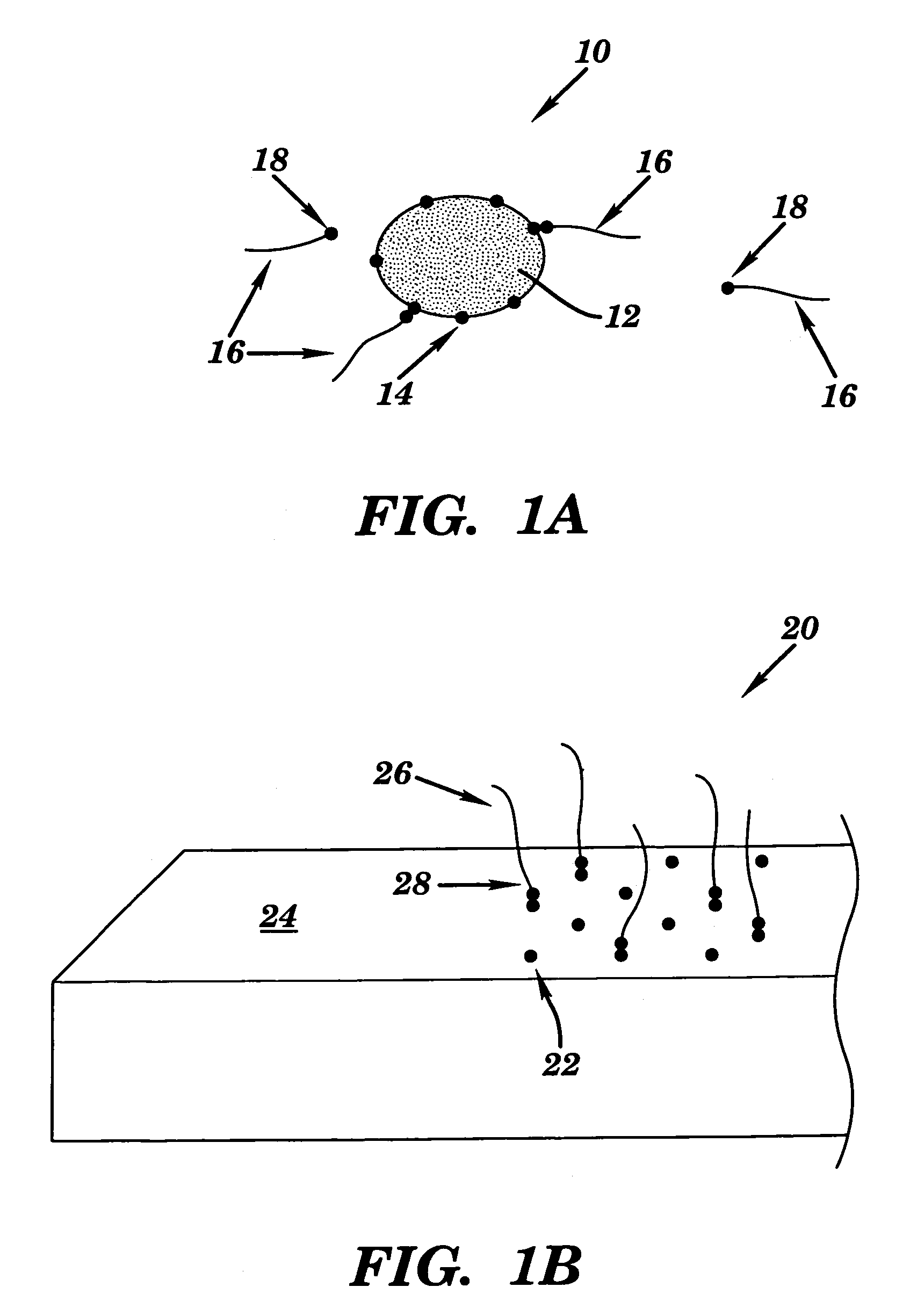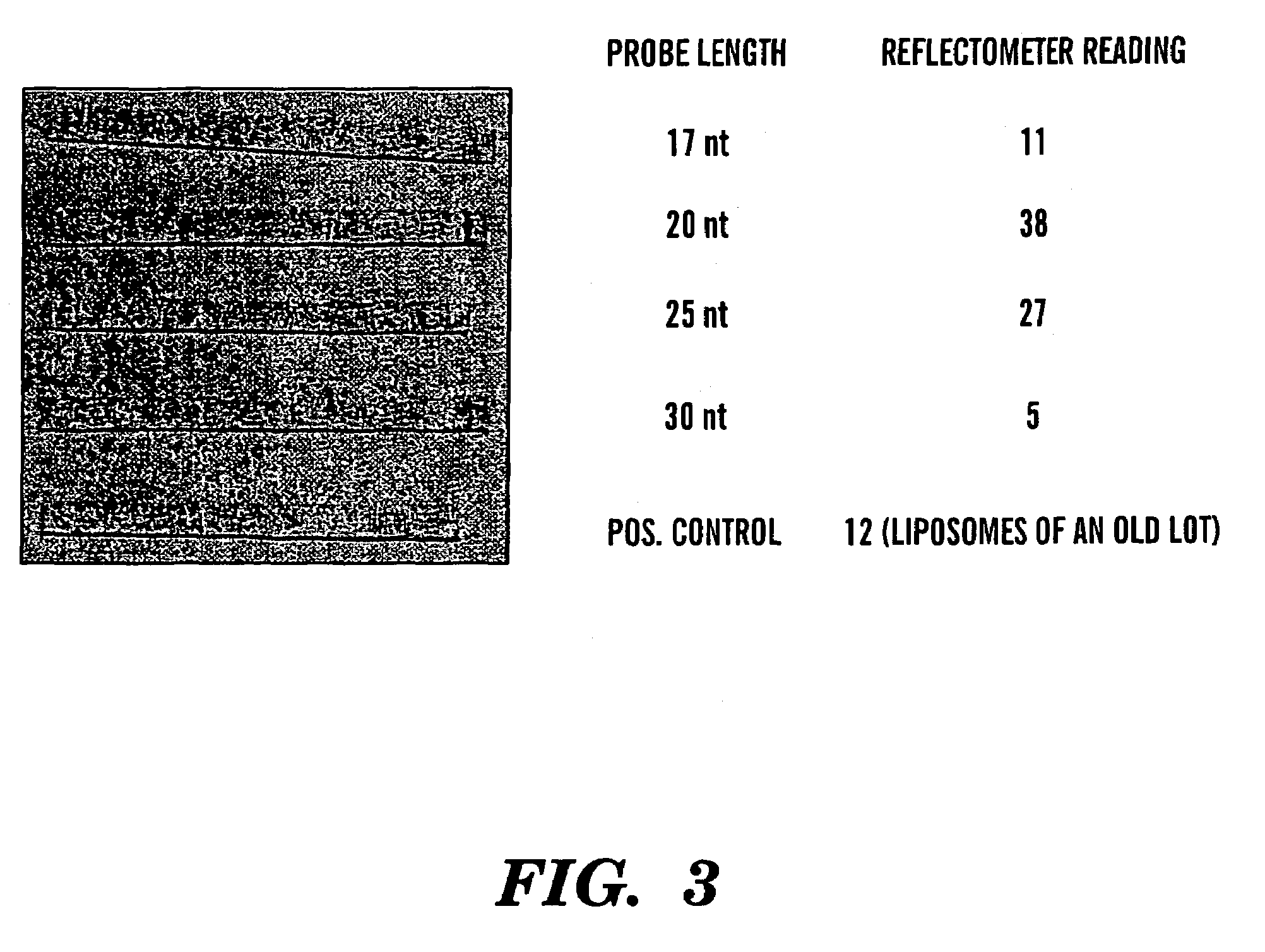Universal biosensor and methods of use
a biosensor and universal technology, applied in the field of universal biosensors, can solve the problems of ethidium bromide being considered very toxic, providing no information on nucleotide sequence, and method that often takes several hours, and achieves the effect of simple, rapid and reliable modification, and rapid modification
- Summary
- Abstract
- Description
- Claims
- Application Information
AI Technical Summary
Benefits of technology
Problems solved by technology
Method used
Image
Examples
example 1
Materials and Methods
Nucleotide Sequences Used in the Following Examples (all listed in the 5′ to 3′ direction)
[0119]Generic 20 nt liposome probe: CCA CCC CCA CCC CCA CCC CC (SEQ ID NO: 1)
[0120]E. coli specific reporter probes: GTC TGG TGA ATT GGT TCC GGG GGG TGG GGG TGG GGG TGG (SEQ ID NO: 2) and GTC TGG TGA ATT GGT TCC (biotinylated at 3′ end) (SEQ ID NO: 3).
[0121]C. parvum specific reporter probe: GTG CAA CTT TAG CTC CAG TTG GGG GTG GGG GTG GGG GTG G (SEQ ID NO: 4).
[0122]Synthetic E. coli target sequence: GGC AAC CGT GTC GTT TAT CAG ACC ACT TAA CCA AGG C (SEQ ID NO: 5).
[0123]Synthetic C. parvum target sequence: A CCA GCA TCC TTG AGC ATT TTC TCA ACT GGA GCT AAA GTT GCA CGG AAG TAA TCA GCG CAG AGT TCT TCG AAT CTA GCT CTA CTG ATG GCA ACT GAA (SEQ ID NO: 6).
[0124]Capture probes are either biotinylated or tagged with fluorescein at 5′ end: E. coli specific capture probe: CCG TTG GCA CAG CAA ATA (SEQ ID NO: 7); C. parvum specific capture probe: AGA TTC GAA GAA CTC TGC GC (SEQ ID NO: 8)...
example 2
Immobilization of Streptavidin on a Liposome Surface
[0126]To couple streptavidin to the liposomes, an activated lipid (DPPE-ATA) was incorporated into the liposomes. Streptavidin was first dissolved in 0.05 M potassium phosphate buffer, pH 7.8, containing 1 mM ethylenediaminetetraacetic acid (EDTA) to a concentration of 100 nmol / mL, to prepare for conjugation to the liposome surface. N-(κ-maleimidoundecanoyloxy) sulfosuccinimide ester (sulfo-KMUS) was then dissolved in dimethylsulfoxide (DMSO) to a concentration of 20.8 μmol / L. 4.3 μL of this stock was added to 100 μL of the streptavidin solution and allowed to react at room temperature in a shaker for 2 to 3 hours.
[0127]Second, the thiol groups on the streptavidin were deprotected by deacetylation of the acetylthioacetate groups. This was accomplished by mixing the streptavidin with a hydroxylamine hydrochloride solution, pH 7.5, containing 0.5 M hydroxylamine hydrochloride, 25 mM EDTA, and 0.4 M phosphate buffer. 28.73 μl of solut...
example 3
Immobilization of a Generic Oligonucleotide on a Liposome Surface
[0129]For the generic probe (SEQ ID NO: 1, above) (5′ end modified with an amine group) and specific reporter probes (E. coli: SEQ ID NO: 3, above; C parvum: 5′ GTG CAA CTT TAG CTC CAG TT 3′ (SEQ ID NO: 9); B. anthracis: 5′ CAA GAT GTC CGC GTA TTT AT 3′ (SEQ ID NO: 10)) (3′ end modified with an amine group), the same protocol as described in Example 2 was followed, using 100 nmol / mL solutions of the oligonucleotides.
PUM
| Property | Measurement | Unit |
|---|---|---|
| pore size | aaaaa | aaaaa |
| pore size | aaaaa | aaaaa |
| pore size | aaaaa | aaaaa |
Abstract
Description
Claims
Application Information
 Login to View More
Login to View More - R&D
- Intellectual Property
- Life Sciences
- Materials
- Tech Scout
- Unparalleled Data Quality
- Higher Quality Content
- 60% Fewer Hallucinations
Browse by: Latest US Patents, China's latest patents, Technical Efficacy Thesaurus, Application Domain, Technology Topic, Popular Technical Reports.
© 2025 PatSnap. All rights reserved.Legal|Privacy policy|Modern Slavery Act Transparency Statement|Sitemap|About US| Contact US: help@patsnap.com



